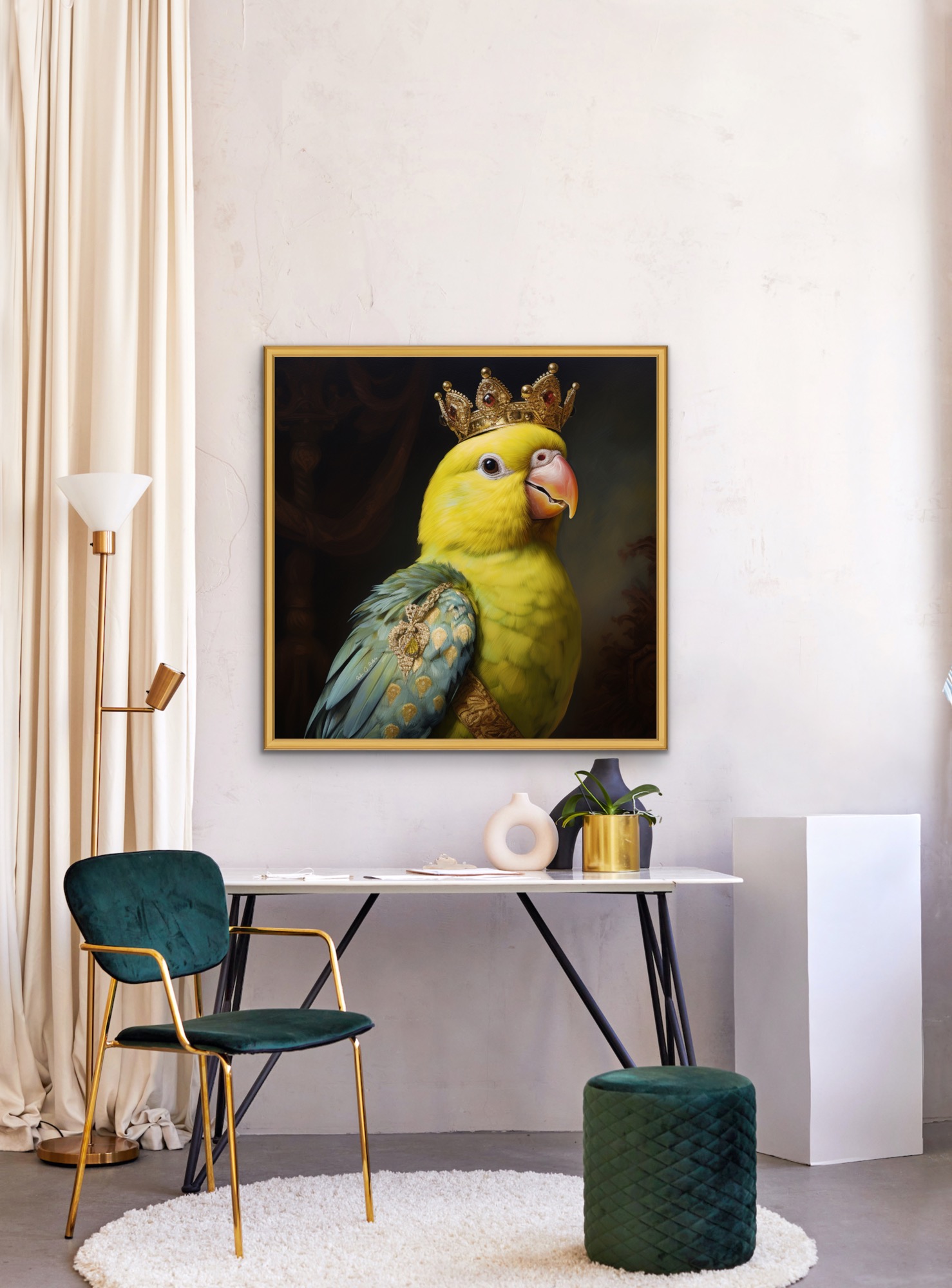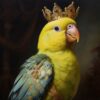In memory of Milo – AI Art
$46.00 – $883.00
Introducing my Technology AI Art category! As many know, I constantly look for new ways to create art and tell a story through visualization. Today something new for all you tech lovers and those interested in the next generation of imagination and creativity based on AI! A strange technological collaboration between AI, my thought creation, and my inner me.
Check out the new line and creations!
The Future is here, but the past will always be present
The image portrays a striking and regal depiction of a parrot adorned in royal attire. The parrot, a vibrant yellow and green bird, sits with a poised and dignified expression, exuding an air of majesty and authority. Its feathers are meticulously detailed, capturing the natural sheen and texture of the bird’s plumage, which contrasts beautifully against the rich, dark background.
The most eye-catching aspect of this parrot’s portrait is the elaborate golden crown perched atop its head. The crown is intricately designed, featuring ornate patterns, gemstones, and a polished finish that reflects the light, giving it a lustrous appearance. The gemstones embedded in the crown vary in color, adding a touch of splendor and emphasizing the bird’s royal status. This crown is not merely an accessory but a symbol of power and nobility, elevating the parrot from a mere creature to a figure of regal stature.
Draped across the parrot’s shoulder is a luxurious piece of fabric that appears to be part of a royal garment. The fabric is rich in texture, with gold embroidery and patterns that add to the overall opulence of the bird’s attire. The colors of the garment complement the parrot’s natural hues, blending shades of gold, green, and blue to create a harmonious and visually pleasing palette. The fabric is adorned with a brooch or medal, further enhancing the parrot’s royal appearance and suggesting that it holds a position of significance or honor.
The background of the image is kept deliberately dark, with subtle hints of shadowy drapery and indistinct shapes that create a sense of depth without drawing attention away from the central figure. This use of a dark backdrop serves to highlight the parrot and its vibrant colors, making it the focal point of the composition. The contrast between the dark background and the brightly colored bird creates a dramatic effect, emphasizing the parrot’s importance and adding to the overall sense of grandeur.
The lighting in the image is soft and carefully controlled, casting gentle highlights on the parrot’s feathers and the golden elements of its attire. The light appears to come from a single source, possibly above and to the side, which creates a natural and realistic depiction of the bird while also adding a touch of drama. The way the light interacts with the parrot’s crown, garment, and feathers adds depth to the image, making the bird appear almost three-dimensional.
The parrot’s expression is one of calm and composed confidence. Its eyes are alert and intelligent, suggesting a creature that is not only beautiful but also wise and aware of its surroundings. The slight tilt of its head gives the parrot a sense of curiosity or contemplation, as if it is observing something of interest beyond the frame. This expression, combined with the royal attire, gives the bird a personality and presence that goes beyond that of a typical animal portrait.
Overall, this image can be seen as a playful yet sophisticated take on traditional portraiture, where the subject, a parrot, is depicted with the same reverence and formality typically reserved for royalty or nobility. The artist has skillfully blended realism with fantasy, using the parrot’s natural beauty as a foundation upon which to build a narrative of grandeur and regality. The attention to detail, from the texture of the feathers to the intricate design of the crown, demonstrates a high level of craftsmanship and creativity.
The image invites the viewer to consider the parrot not just as a bird but as a symbol of power, elegance, and perhaps even a reminder of the natural world’s inherent beauty and nobility. The juxtaposition of the parrot’s natural form with the human concept of royalty creates a captivating and thought-provoking piece that lingers in the viewer’s mind, evoking a sense of wonder and admiration for both the subject and the artistic vision behind it.
| FrameSize | 8×8 inches (20×20 cm), US and Mexico, 10×10 inches, US only, 11×11 inches, US only, 12×12 inches (30x30cm), US and Mexico, 16×16 inches (40×40 cm), Mexico only, 20×20 inches (50×50 cm), US and Mexico, 24×24 inches (60×60 cm), US and Mexico, 28×28 inches (70×70 cm), Mexico only, 30×30 inches, US only, 32×32 inches (80×80 cm), Mexico only, 36×36 inches (90×90 cm), Mexico only, 40×40 inches (100×100 cm), US and Mexico, 47×47 inches (120×120 cm), Mexico only |
|---|
Related products
AI ART
AI ART













